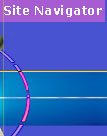 |
 |
 |
|
| The basic concept of' figure' and 'ground' is an outcome of Gestalt psychologists, Max Wertheimer (1880 -- 1943), Wolfgang Koher (1887 -- 1967) and Kurt Koffka (1886 -- 1941). These psychologists advocated that when an individual is confronted by any ( abstract or symbolic ) visual image, we seem to separate a dominant shape (a 'figure' with definite contours) from the background. The famous ambiguous figure devised by the Danish psychologist Edgar Rabin (figure 12) is the most appropriate example to explain the figure ground relationship. In addition |
 |
 |
|
|
workshop theory slide gallery |
 |
||
|
to introducing the terms 'figure' and 'ground' Gestalt psychologists outlined several fundamental irreversible principles of perception and organisation. |
|||
|
|
|||
|
12.01
- PROXIMITY : (figure 13, 14, 15) |
|||

|
 |
 |
|
| (figure 13) | (figure 15) | (figure 14) | |
|
12.02
- SIMILARITY : (figure 16 & 17) |
|||
(figure
16)  (figure
17) (figure
17) |
|||
|
12.03
- CONTINUITY : (figure 18) |
|||
|
12.04
- CLOSURE : (figure 19 & 20) |
|||
 (figure
19) (figure
19) |
|||
 (figure 20)
(figure 20) |
|||
|
12.05
- SMALLNESS : (figure 21 & 22) |
|||
(figure 21) 
 (figure 22)
(figure 22) |
|||
|
12.06
- SYMMETRY : (figure 23) |
|||
 (figure 23)
(figure 23) |
|||
|
12.07
- SURROUNDNESS : (figure 24) |
|||
 (figure 24)
(figure 24) |
|||
| « back to topics | |||
 (figure 12)
(figure 12) (figure
18)
(figure
18)